My summers in Canlubang, Laguna were always filled with the sweet aroma of Sinukmani from my Tita Julie's kitchen.
I'll never forget the first time I watched her make this traditional Filipino rice cake, the way her practiced hands expertly stirred the thick mixture of malagkit rice and coconut milk, patiently waiting for that perfect golden-brown color and the latik to form.
It wasn't just about the cooking, it was about the stories she shared while we waited, the way she'd let me sneak a taste of the caramelized coconut curds, and how the entire house would fill with that irresistible toasty coconut smell.
This family recipe has been passed down through generations. And after years of learning from my Tita Julie, I'm excited to share our version of this beloved kakanin that has graced countless Filipino celebrations and merienda times.
Jump to:
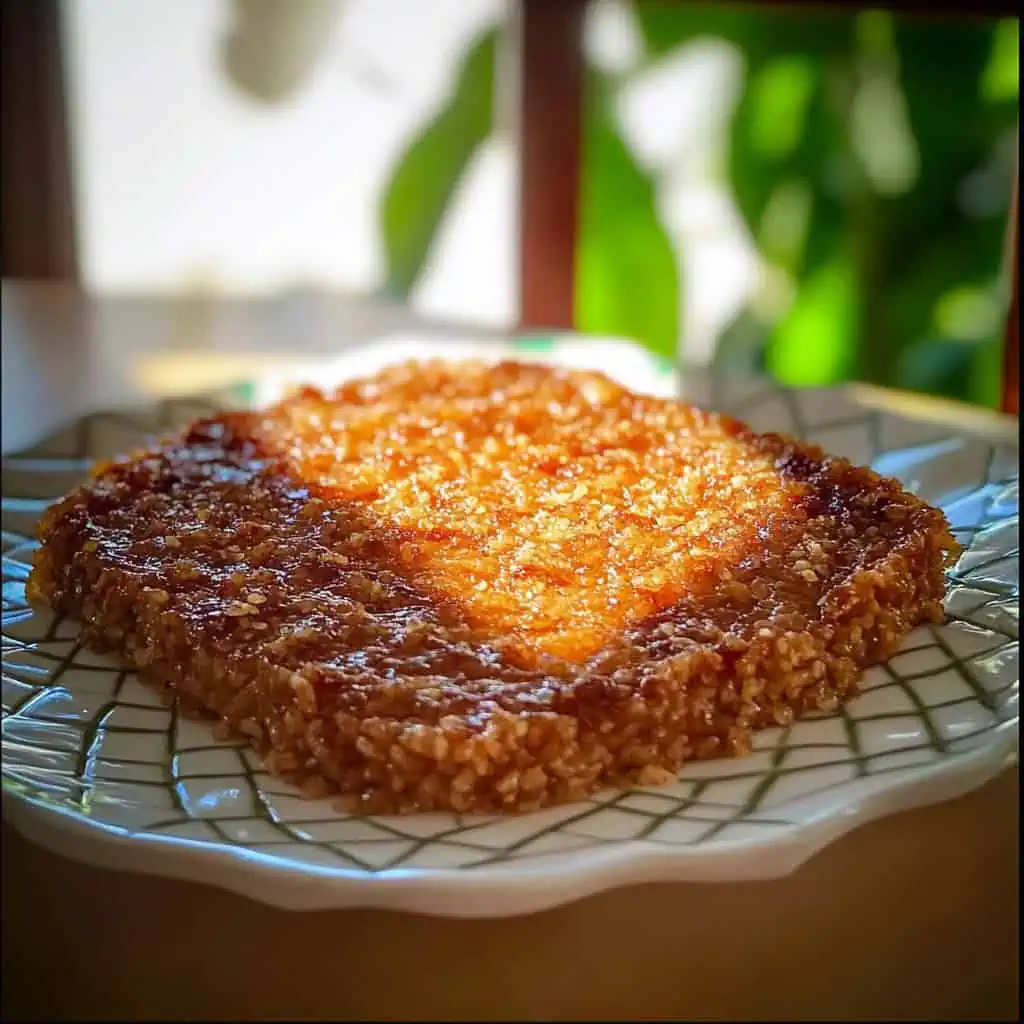
Why You'll Love This Recipe
- Authentic family recipe scaled for big gatherings
- Creates perfectly chewy rice cake with caramelized coconut topping
- Step-by-step instructions with Tagalog translations
- Perfect for fiestas and special occasions
- Rich cultural significance in Filipino cuisine
- Made with just 4 simple ingredients
Ingredients
This recipe relies on just four essential ingredients that create magic together. Glutinous rice provides the sticky, chewy texture that's fundamental to Filipino kakanin. Brown sugar offers deep caramel notes that can't be achieved with white sugar.
Coconut milk contributes richness and creates the prized latik (coconut curds), while banana leaves impart a subtle aroma and prevent sticking, all representing the beautiful simplicity of traditional Filipino cooking.
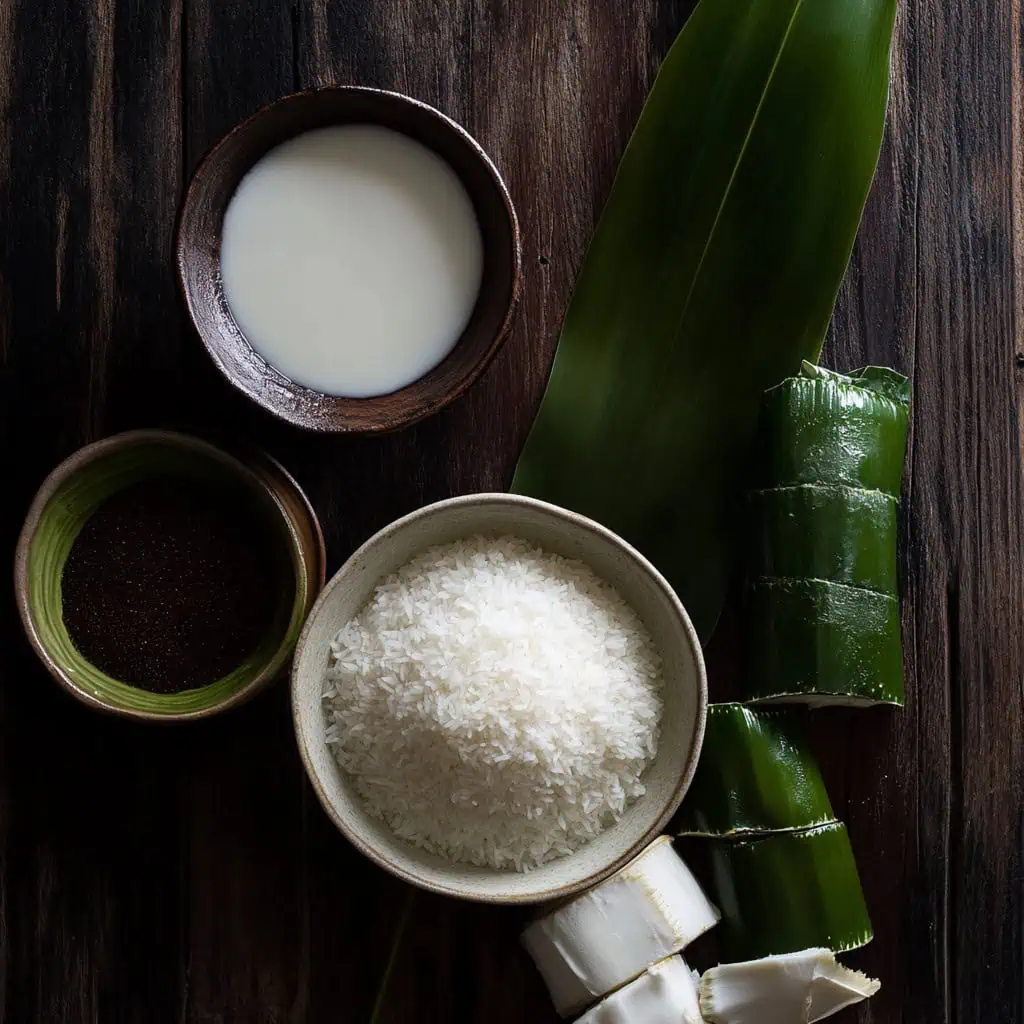
- 2 kg glutinous rice (malagkit/pirurutong)
- 1 kg brown sugar
- 6 cans (500ml each) coconut milk, or 3 whole fresh coconuts, grated
- Banana leaves for lining the serving tray
Equipment
- Large pot (kaldero) - For cooking the glutinous rice properly until tender
- Deep heavy-bottomed pan or carajay - Essential for making latik and preventing burning
- Wooden spoon (sandok) - For constant stirring and preventing the mixture from sticking
- Food processor (optional) - Helps in chopping latik into smaller, more even pieces
- Bilao or wide flat serving plate - Traditional serving vessel that allows for proper cooling and setting
- Measuring cups and spoons - For precise measurement of ingredients ensuring consistent results
- Cheesecloth or strainer - For extracting coconut milk if using fresh coconuts
- Sharp knife - For cutting banana leaves and portioning the finished product
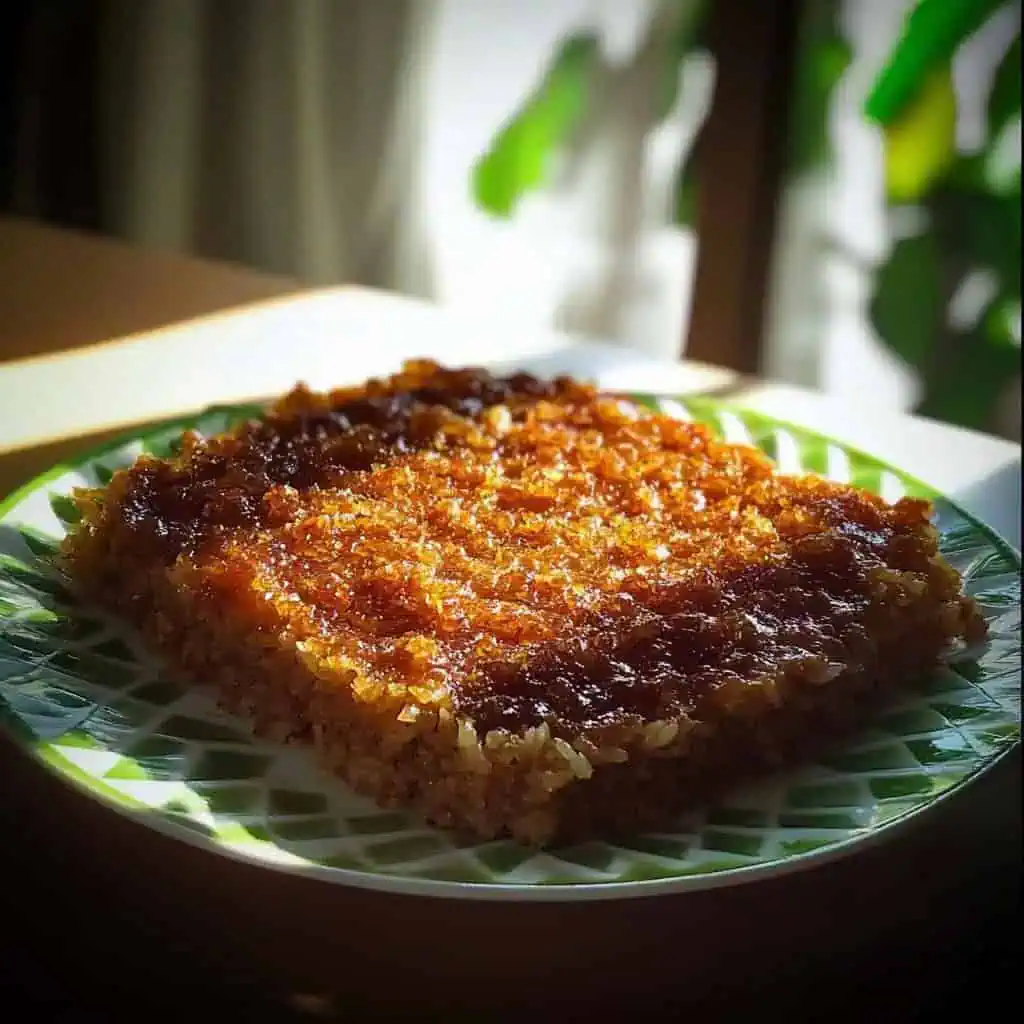
How To Make
- Before starting, prepare all your ingredients and equipment. Line your serving tray with banana leaves.
- Wash 2 kilos of glutinous rice until water runs clear. Cook it in a large pot or rice cooker with equal parts water, just like cooking regular rice.
- While rice is cooking, pour 3 cans (1.5L) of coconut milk in a deep pan. Cook over medium heat, stirring non-stop until it forms golden-brown curds (latik). This takes about 15-20 minutes. Remove the latik with a strainer and chop into small pieces. Save the coconut oil in the pan.
- In the same pan with coconut oil, add the remaining 3 cans of coconut milk and 1 kilo brown sugar. Cook on medium heat, stirring constantly until it thickens and turns caramel-colored. This takes about 20 minutes.
- Once rice is cooked, add it to your caramel mixture. Mix everything well – this needs muscle work! Keep stirring until rice is evenly coated with the caramel and turns golden brown.
- Transfer everything to your banana leaf-lined tray. Press down firmly to make an even layer. Sprinkle chopped latik on top. Let cool for 30 minutes.
- Cut into diamond shapes and serve. You can enjoy it warm or at room temperature.

Tips from Lola's Kitchen
- Use day-old rice for better texture - cooked rice that has rested overnight absorbs flavors better and creates the ideal chewy consistency
- Keep stirring speed consistent to prevent burning - maintain a steady rhythm when stirring the mixture to ensure even heat distribution
- Test caramel thickness by dropping in cold water - it should form a soft ball when ready, indicating perfect consistency
- Fresh coconut milk yields better flavor than canned - the aromatic qualities of fresh coconut enhance the authentic taste
- Banana leaves add traditional aroma and prevent sticking - they impart a subtle fragrance and create a natural non-stick surface
- Use muscovado sugar for deeper flavor - this less refined sugar adds complexity and richness to the caramel notes
Substitutions
- Brown sugar: Can be replaced with muscovado or palm sugar for a more complex flavor profile
- Canned coconut milk: Substitute with fresh coconut milk from 3 whole coconuts for enhanced taste and texture
- Banana leaves: If unavailable, use greased parchment paper as a practical alternative
- Glutinous rice: For a unique variation, try black glutinous rice which offers a striking purple-black color and nuttier flavor
Troubleshooting
- Too sticky: Add more coconut milk gradually while stirring to achieve desired consistency
- Too dry: Incorporate warm coconut milk while mixing to moisten the mixture
- Burning bottom: Lower heat immediately and stir more frequently, especially around the edges
- Latik too dark: Remove from heat earlier in the process - dark brown means it's close to burning
- Not setting properly: Cook longer to reduce moisture content, ensuring the mixture pulls away from the sides of the pan
Storage & Reheating
- Store in an airtight container at room temperature for up to 2 days
- Refrigerate for up to 5 days to maintain freshness
- Reheat in a steamer for 5-10 minutes to restore the soft texture
- Do not microwave as it significantly alters the texture
- Always bring to room temperature before serving for the best flavor and texture experience

FAQ
Can I halve the recipe?
Yes, simply divide all ingredients by 2. Cooking time will reduce by approximately 15-20 minutes.
Why isn't my latik forming?
Use full-fat coconut milk and maintain consistent medium heat throughout the process. Low-fat coconut milk won't separate properly.
How do I prevent the bottom from burning?
Use a heavy-bottomed pan and stir constantly, especially when the mixture begins thickening. Keep heat at medium-low rather than high.
Can I freeze Sinukmani?
Not recommended as freezing significantly affects the texture, making it grainy when thawed.
How do I know when it's done?
The mixture should be very thick and pull away from the sides of the pan. When you run your wooden spoon through it, it should leave a clear path that slowly fills in.
How long does it take to make the latik?
Typically 15-20 minutes of continuous stirring, but this varies based on heat level and coconut milk quality. Watch for the color change from white to golden brown.
Can I add other flavors to the recipe?
Yes, pandan extract, vanilla, or a small amount of ube (purple yam) can be incorporated for flavor variations while maintaining the traditional essence.
Is there a way to reduce the sweetness?
Reduce the sugar by up to 20% for a less sweet version, but be aware this may affect the caramelization process and overall texture.
Related
Looking for other recipes like this? Try these:
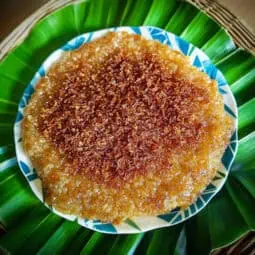
Sinukmani ng Laguna (Biko)
Equipment
- Large pot (kaldero) for cooking glutinous rice
- Deep heavy-bottomed pan or carajay for making latik
- Wooden spoon (sandok) for constant stirring
- Food processor (optional) for chopping latik
- Bilao or wide flat serving plate for molding and serving
- Measuring cups and spoons (Panukat) for precise measurement
- Cheesecloth or strainer (salaan) for extracting coconut milk if using fresh coconut
- Sharp knife (kutsilyo) for cutting banana leaves and finished product
Ingredients
- 2 kg glutinous rice malagkit/pirurutong
- 1 kg brown sugar asukal na pula
- 6 cans 500ml each coconut milk (gata) or 3 whole coconuts, freshly grated
- Banana leaves dahon ng saging for lining
Instructions
- Before starting, prepare all your ingredients and equipment. Line your serving tray with banana leaves.
- Wash 2 kilos of glutinous rice until water runs clear. Cook it in a large pot or rice cooker with equal parts water, just like cooking regular rice.
- While rice is cooking, pour 3 cans (1.5L) of coconut milk in a deep pan. Cook over medium heat, stirring non-stop until it forms golden-brown curds (latik). This takes about 15-20 minutes. Remove the latik with a strainer and chop into small pieces. Save the coconut oil in the pan.
- In the same pan with coconut oil, add the remaining 3 cans of coconut milk and 1 kilo brown sugar. Cook on medium heat, stirring constantly until it thickens and turns caramel-colored. This takes about 20 minutes.
- Once rice is cooked, add it to your caramel mixture. Mix everything well – this needs muscle work! Keep stirring until rice is evenly coated with the caramel and turns golden brown.
- Transfer everything to your banana leaf-lined tray. Press down firmly to make an even layer. Sprinkle chopped latik on top. Let cool for 30 minutes.
- Cut into diamond shapes and serve. You can enjoy it warm or at room temperature.
Tips from Lola's Kitchen
- Use day-old rice for better texture
- Keep stirring speed consistent to prevent burning
- Test caramel thickness by dropping in cold water - should form soft ball
- Fresh coconut milk yields better flavor than canned
- Banana leaves add traditional aroma and prevent sticking
- Use muscovado sugar for deeper flavor
Nutrition
The Story Behind Sinukmani ng Laguna (Biko)
Deep in the heart of Laguna province, Sinukmani stands as a testament to the ingenuity of Filipino cuisine, where simple ingredients transform into something extraordinary. This cherished rice cake, known as Biko in Manila and other regions, traces its roots to our ancestors' resourcefulness with the abundance of coconuts and glutinous rice in the Philippine archipelago. Like many beloved Filipino kakanin, Sinukmani emerged from the practice of cooking rice with coconut milk (gata) – a method that predates Spanish colonization and reflects our Austronesian heritage.
In Laguna, particularly in towns like Canlubang, Calamba, and San Pablo, Sinukmani has evolved into its own distinct variety. Local families take pride in their versions, often distinguished by the darkness of their caramel, the chewiness of the malagkit, or the crunchiness of their latik topping. What makes Laguna's Sinukmani special is the meticulous process of creating latik – where coconut milk is patiently cooked until it releases its oils and forms golden-brown curds, a technique that requires both skill and patience passed down through generations.
The name "Sinukmani" itself tells a story, derived from the Tagalog words "sinukat" (measured) and "mani" (peanut), possibly referring to its traditional diamond-shaped cuts that resemble peanut patterns. Meanwhile, "Biko" is thought to come from the word "biko-biko," describing its sticky, chewy texture. This dual naming reflects not just regional differences but also the rich linguistic heritage of Filipino food culture.
Today, Sinukmani continues to hold a special place in Filipino celebrations, from traditional fiestas to modern gatherings. Its presence at events signifies the continuation of Filipino culinary traditions, where each bite connects us to our cultural heritage. Whether enjoyed during afternoon merienda or as a festive dessert, this classic kakanin reminds us of the simple yet profound ways food brings Filipino families together, one sweet, sticky serving at a time.
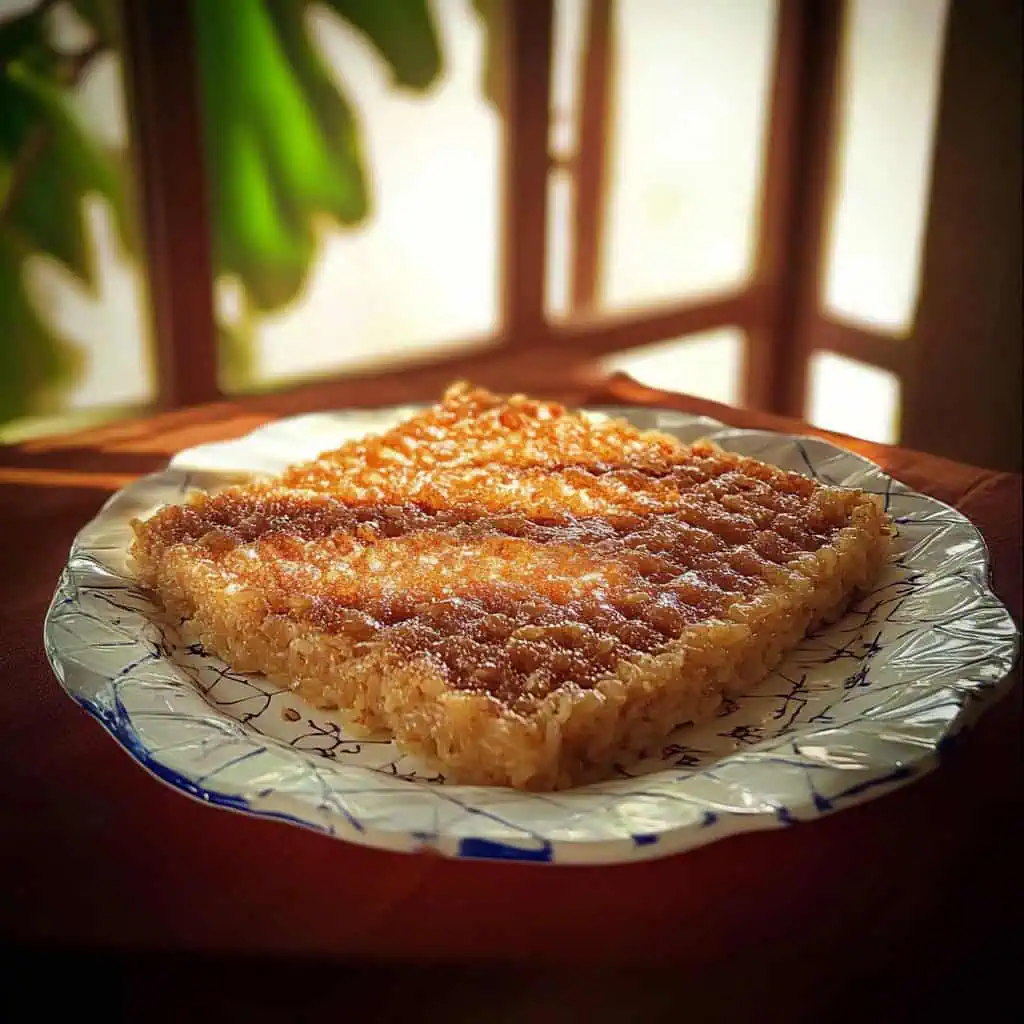





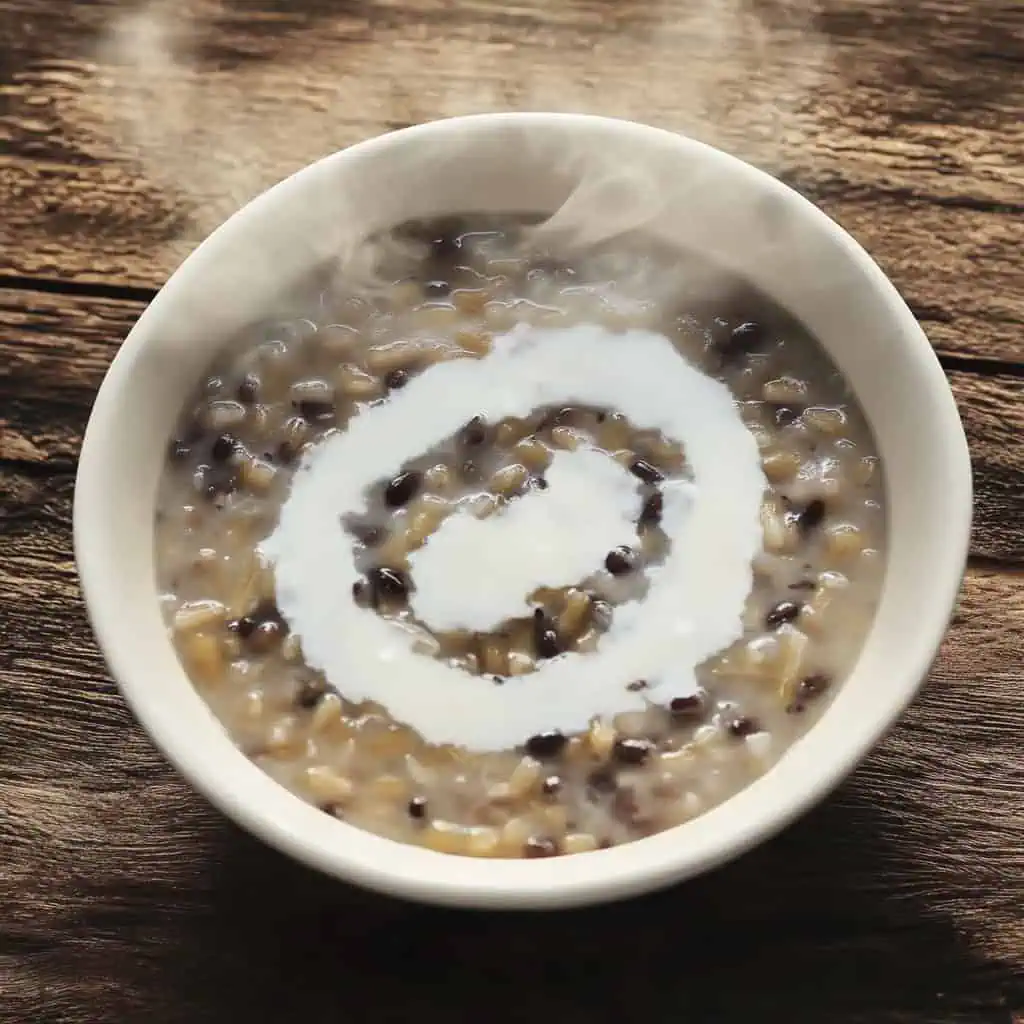
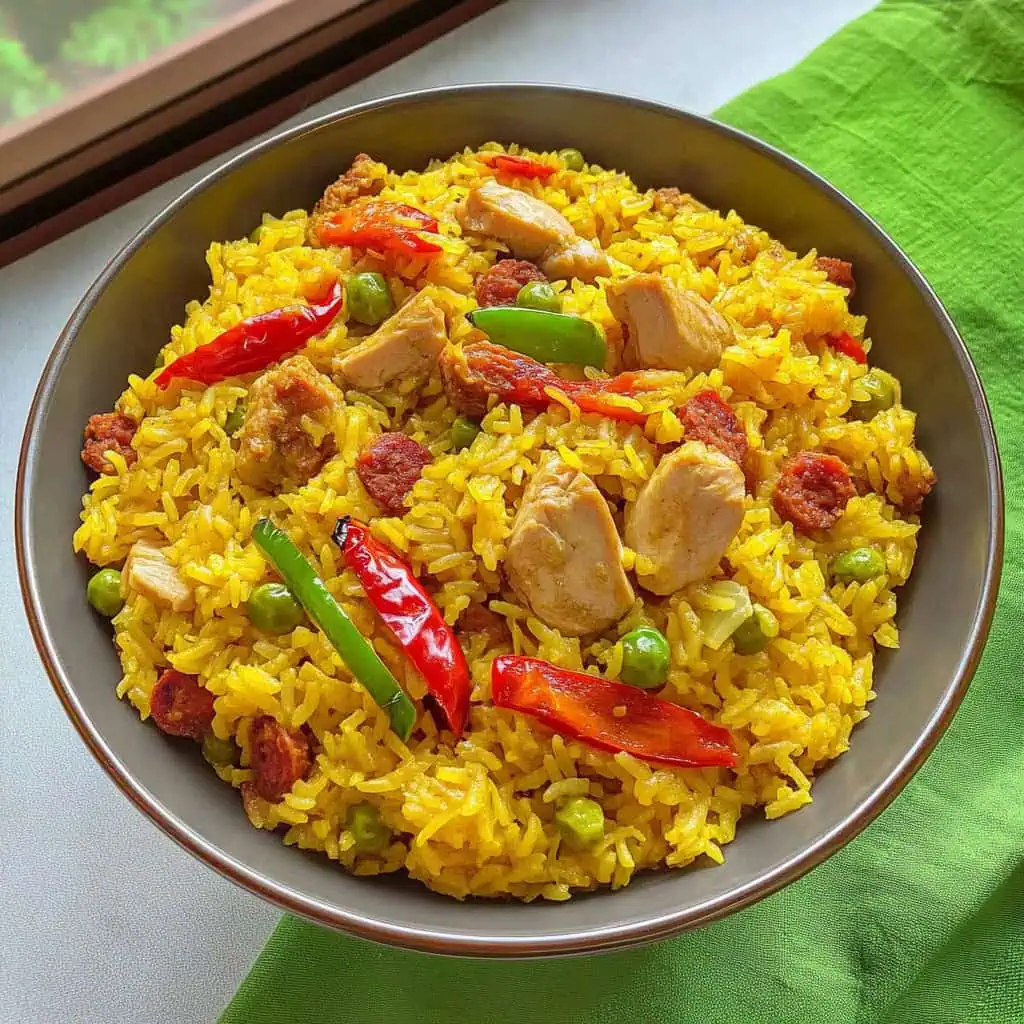
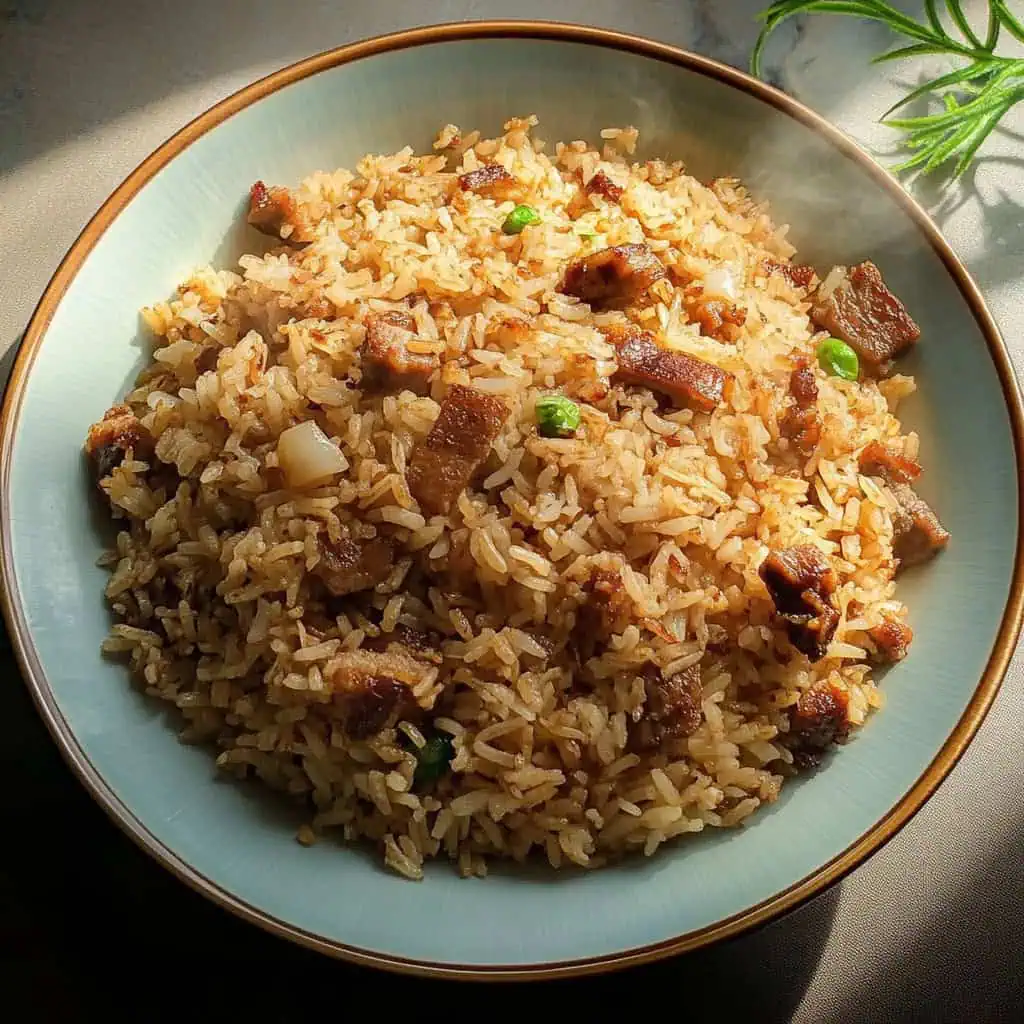
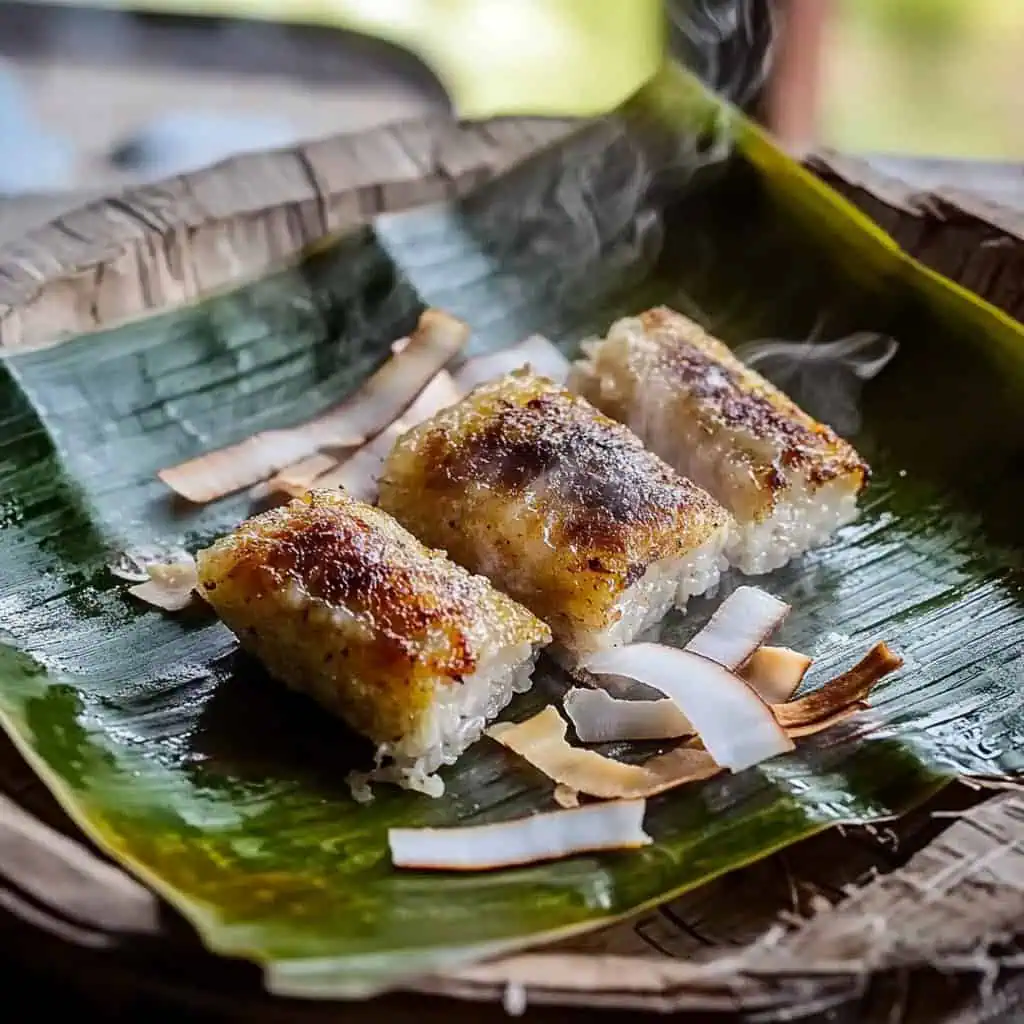
Comments
No Comments